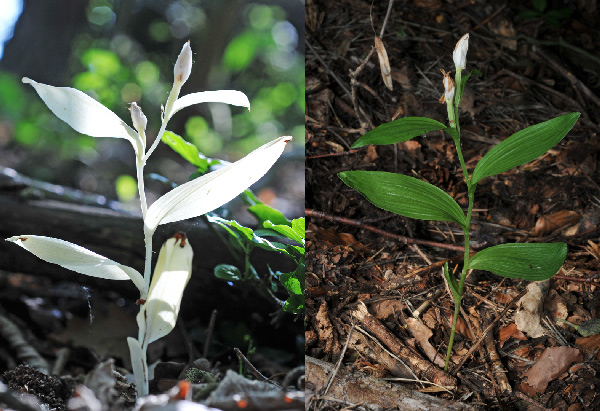 It is well studied that Cephalanthera damasonium belongs to those orchids which can live without chlorophyllum – together with other species of the tribe of Neottieae or the genus Epipactis. While exploring a mixed forest near Lahnstein (Rhineland-Palatinate) together with Ingo Beller of the Arbeitskreis Heimische Orchideen (AHO) Rheinland-Pfalz, we found a group of three albino plants in addition to three green-leafed Cephalanthera damasonium. Of the apochromic plants one has two flowers, one only one flower and one has no flower. Those albino plants receive their organic carbon with the help of fungi. A study of V. Tranchida-Lombardo, M. Roy, E. Bugot, G. Santoro, Ü.Püttsepp, M. Selosse and S. Cozzolino, published in 2010 in Plant Biology suggests that the albino Cephalanthera damasonium may be viewed as “an intermediate step in the evolutionary emergence of mycoheterotrophy”, or of the ability to be nourished both by fungi and photosynthesis. By means of genetic analyses the authors declare: “Albinos could be either permanent mutants, as suggested by phenotype stability over the years, or transitory phenotypic stages, in which genes involved in the photosynthetic pathway can switch off depending on micro-environmental conditions (e.g., the amount of C resources provided by the nearby fungal mycelia or tree roots) that prevent greening.”
It is well studied that Cephalanthera damasonium belongs to those orchids which can live without chlorophyllum – together with other species of the tribe of Neottieae or the genus Epipactis. While exploring a mixed forest near Lahnstein (Rhineland-Palatinate) together with Ingo Beller of the Arbeitskreis Heimische Orchideen (AHO) Rheinland-Pfalz, we found a group of three albino plants in addition to three green-leafed Cephalanthera damasonium. Of the apochromic plants one has two flowers, one only one flower and one has no flower. Those albino plants receive their organic carbon with the help of fungi. A study of V. Tranchida-Lombardo, M. Roy, E. Bugot, G. Santoro, Ü.Püttsepp, M. Selosse and S. Cozzolino, published in 2010 in Plant Biology suggests that the albino Cephalanthera damasonium may be viewed as “an intermediate step in the evolutionary emergence of mycoheterotrophy”, or of the ability to be nourished both by fungi and photosynthesis. By means of genetic analyses the authors declare: “Albinos could be either permanent mutants, as suggested by phenotype stability over the years, or transitory phenotypic stages, in which genes involved in the photosynthetic pathway can switch off depending on micro-environmental conditions (e.g., the amount of C resources provided by the nearby fungal mycelia or tree roots) that prevent greening.”